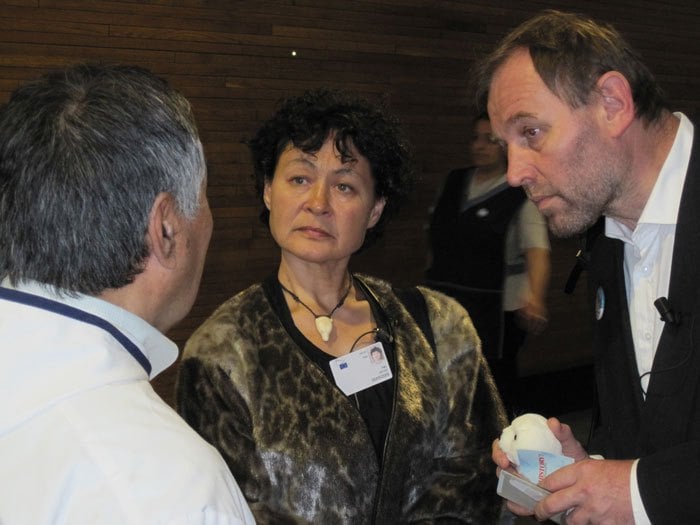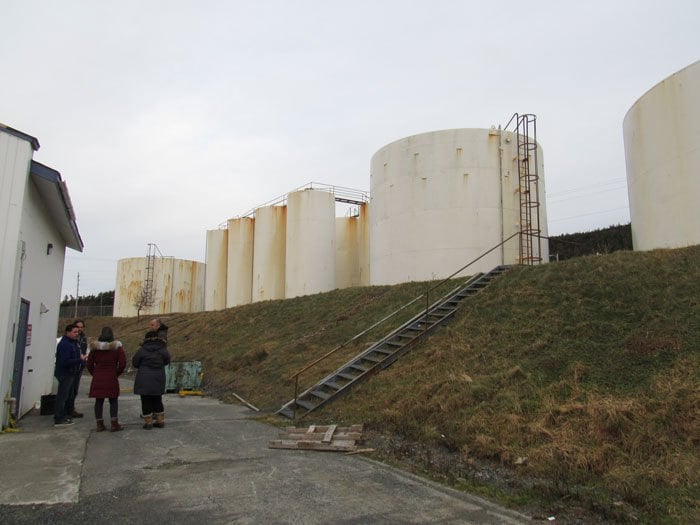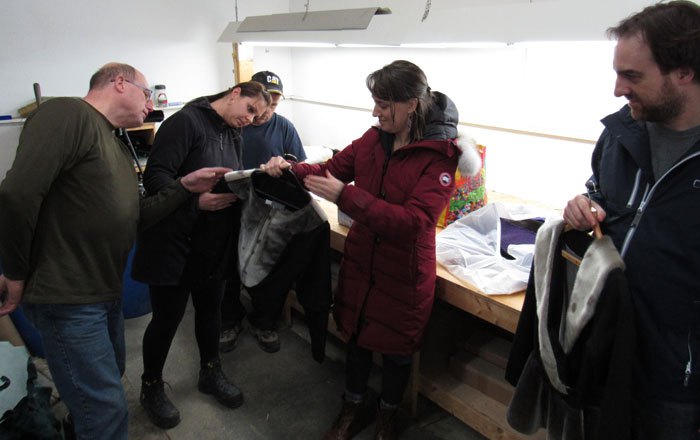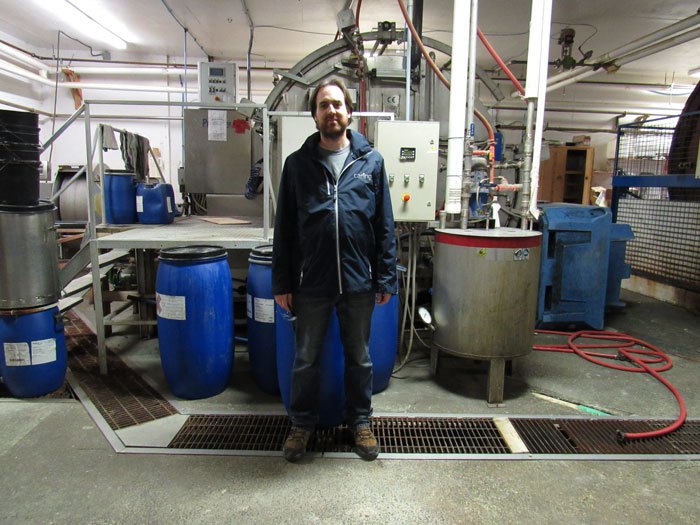by FELICITY ROBERTS originally posted on The Overcast – Newfloundland’s Alternative Newspaper on December 22, 2016
Seals have been politicised for decades now. No matter where you stand on the hunt, there’s no debating the fact that the high profile campaigns of the 70s and 80s, by for-profit groups like Greenpeace and the IFAW (International Fund for Animal Welfare), did very serious damage to the industry, and with it, the families and communities that depend on it.
It was during those times, with the United States introduction of the Marine Mammal Protection Act in 1972, and resulting collapse of the seal market, that Inuk journalist Ossie Michelin tells me his stepfather saw a grown man cry.
“An old Inuk sealer had come to the wharf in Rigolet to sell his pelts, and was informed that new regulations were now in place, and there was no more market for seal pelts. He realized at that moment he could no longer feed his family, and would have to leave his home and get a job in Goose Bay. He had lost everything, and he cried.”
Newfoundlanders have lost much as well, as Dion Dakins tells me. Dakins is the CEO of Carino Processing Limited, a Trinity Bay plant which processes seal pelts and oil. In 2009, he and a Canadian delegation went to Brussels to educate EU parliamentarians about misinformation surrounding the hunt, before a vote on an EU seal ban (which passed). Animal rights activists characterise the hunt as cruel, and often use outdated imagery and unsubstantiated claims to discredit it.
“It was so terrifyingly sad and frustrating to not be able to change the gravity,” Dakins says. “No one listened to us. Minds [were]made up on propaganda.”
He shows me a picture taken while there, of Inuit leaders Aaju Peter and Simon Awa (who appear in the film Angry Inuk, which addresses the effect these campaigns have on Inuit communities) trying to tell European Union MEPs, before the vote on the seal ban, that it would have negative consequences for Inuit. Held in one MEPs hand is a white coat plush toy given out by IFAW hours before the vote. White coats have not been hunted since the 1980s!

One piece of misinformation that is currently being pushed by a new group in St. Johns called Save Our Seals is that only 8% of the seal is used after harvest. The fact that an average seal is approximately 35% body fat blows this out of the water. The pelts arrive with blubber attached , which is separated in a food grade facility and rendered into oil. 800,000 litres of it, that’s Carino’s yearly average. Much of it is used in the health food industry, and some goes to fortifying livestock feed with omega oils. The waste fraction is used to heat and power the plant.

Dakins, who enjoys seal meat, finds the effect of anti-sealing protests on meat sales to be one of his greatest frustrations with the animal rights rhetoric: he feels conflicting claims demonise the industry if meat is wasted, but actively prevent new markets for seal meat through smear campaigns.
“These groups actively work to erode market opportunities before we can capitalise on the ones we create. False imagery or statements is not a concern for them,” Dakins states.
Chef Jeremy Charles of Raymonds and Merchant Tavern fame is a champion of seal meat.
“It’s something that we serve. It’s a beautiful, wild, organic and sustainable protein that we have surrounding us.”
Charles feels it’s an abundant local protein that’s been overlooked for too long, and wants to help educate people as to why they should be eating more of it.
Dakins says he’s reached out and asked members of the Save Our Seals group to tour Carino’s plant and speak with workers, but to no response. Numerous attempts to reach the new and mysterious group were rebuffed as soon as any request was made to speak to a member using their real name. On my tour of Carino’s facility, I brought sealskin crafter Clare Fowler and vegetarian Danielle Knustgraichen, and Dion explained the details of the hunt and the regulations regarding a humane kill, pointing out public scrutiny has caused the seal industry to have to hold itself to much higher standards than that of factory farms.

So who are Save Our Seals? The group’s Facebook page is the only source of information I can find about them, other than a promotional video shot in St. Johns by a Toronto studio employing a Toronto actor, and an article by none other than Sheryl Fink of IFAW notoriety.
IFAW is a particularly worrisome group to Inuit communities. The Nunavut filmmaker behind Angry Inuk, Alethea Arnaquq- Baril, has interviewed Fink, spoken at length with her, and says that IFAW has been given correct information about the hunt and is aware its depiction of the Inuit hunt as being somehow different than the commercial hunt is incorrect. The IFAW can’t be opposed to the commercial hunt, not the Inuit hunt, because the Inuit hunt IS a commercial hunt. “The majority of commercial seal hunters are Inuit” Arnaquq-Baril states, yet some groups have chosen to ignore this, and their efforts to end the commercial hunt drastically affect livelihood for the Inuit community.
This is a tactic embraced by Save Our Seals, who have deleted Inuit comments attempting to correct misinformation, or the comments of anyone who question their claims, such as Dakins. Both he and Arnaquq-Baril have been blocked by the page, and Ossie Michelin has had many comments pointing out the colonial attitude of the group deleted, but has screen captured them to share. A high number of those using real names are located in California or Ontario.
“We have no respite” Ossie says. “So much has been taken away from us. On so many fronts, it is an active struggle to keep our culture alive.” Arnanquq- Baril is equally frustrated with these groups. “It’s very hard to fight against entities who remain hidden. It’s very easy for them to damage us from a distance. They have no personal stake in this matter.”
Personal stakes are pretty high for the 27 workers at Carino. A chemist named Jason tells me how he left the industry briefly, but despite continued threats to its existence from outside forces, he’s back, and he’s happy. He’s very proud of the dyeing method they use for the pelts, it’s a model of environmental responsibility, something tanneries are not generally associated with.

I met Lisa doing inventory in the warehouse area. She is a seal skin crafter, in addition to working at the plant. I apologised in advance for having to ask such a question, “I am attempting to clear up some misconceptions being promoted right now by a group that says it’s from St. John’s. One thing they say is that people don’t want to work in this industry and wish they had other options. What do you have to say about that? Do you like your job?”
With the biggest smile I have ever seen take over a woman’s face, she grabbed a pelt, ran it through a piece of equipment which precisely measures it, and said emphatically “I love it.”





“Seals have been politicised for decades now. No matter where you stand on the hunt, there’s no debating the fact that the high profile campaigns of the 70s and 80s, by for-profit groups like Greenpeace and the IFAW (International Fund for Animal Welfare), did very serious damage to the industry, and with it, the families and communities that depend on it.”
Thanks. Loved the laugh I got from this. ‘Politicised Seals’, “…for-profit-groups…” (Oh that made me roll on the floor. An industry the members of which stand on the bloody corpses of animals, gutting and skinning them complains about Greenpeace), “…damage to the industry…” (yup, way more important that needlessly killing animals. Too right matey!).
I had to comment because the article was a real Trumpian endeavour. Well done. Am sharing it right now.
Thank you for the informative article. There is so much hypocrisy when it comes to seal hunt. Seals are a very natural and sustainable source of so many things including fur, meat, and oil. Newfoundlanders and Labradorians and Canadians in general don’t even come close to harvesting the allowable limit of harp seals each year. Estimates indicate there are over 7 million harp seals and even though something like 400,000 are allowed to be harvested, only around 66,000 are actually taken each year meaning the stock is very healthy.
I operate the websites http://www.TerraNovaSealOil.com and http://www.Plantology.ca on which I sell seal oil manufactured by Carino under the brand name of Terra Nova Omega-3 Seal Oil. It is an excellent source of omega-3 including DPA which is an omega-3 often not found in many supplements.
I say this to be totally upfront. But people just need to look at all the facts. Seals provide so many things including oil which is sent all over Canada and to Asia as well.
We know that some groups are heavily funded. This includes Green Peace which has annual revenue of $400M USD (in 2014). That’s a pretty massive amount of revenue and much it is spent on the destruction of this sustainable industry.
Anyway, keep up the great work of promoting this great industry!